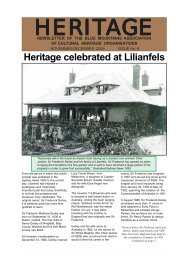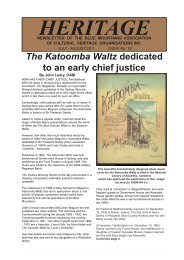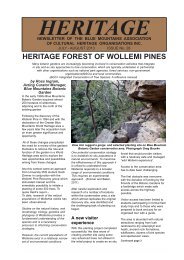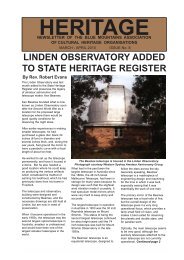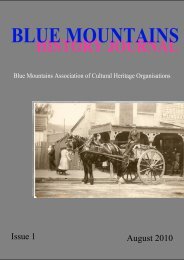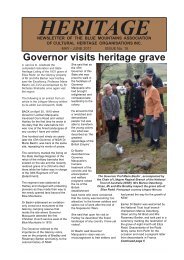A Springwood soldier laid to restat Fromelles 94 years laterPamela Smith and I attended thelaunch <strong>of</strong> Glenbrook HistoricalSociety’s Comrades in Arms whichwas composed <strong>of</strong> short biographies<strong>of</strong> Glenbrook men who had servedin World War I.We were inspired to beginresearching and writing about themen who were listed on theSpringwood District World War IHonor Roll.by Shirley Evans, Springwood HistorianThis proved to be very much moredifficult than we had thought, but inthe five years it took to complete thetask we became very close to ourWorld War I veterans and mournedthose who had died in that dreadfulwar.In his introduction to our book,Remembrance: Springwood DistrictHonor Roll 1914-1919 John Lowwrote: “Their research has rescuedthe men recorded here from thecreeping anonymity that would havebeen their fate and given them backto their community as individualswho lived and breathed their ownspecial human uniqueness.”These men (and they were all men,no women) were certainly to adegree anonymous with the boardhung inconspicuously on a side wallin the Springwood Civic Centre, andwith many <strong>of</strong> the men proving quitedifficult to identify.A very few <strong>of</strong> them bore names werecognised from our research forThe Making <strong>of</strong> a MountainCommunity: a BiographicalDictionary <strong>of</strong> the SpringwoodDistrict, but quite a number wediscovered in the Nepean Timesreports <strong>of</strong> Springwood in the waryears.One <strong>of</strong> these names was Ed Hope(proved to be Edward James Hope),born and reared in Kingswood. Hewas employed by the railway as afettler at the time <strong>of</strong> his enlistmentand we found that his nameappeared on the St Mary’s Roll <strong>of</strong>Honour in Victoria Park and also onthe <strong>Blue</strong> <strong>Mountains</strong> District WarMemorial Hospital, Katoomba.The last <strong>of</strong> the exhumed soldiers being carried to his last restingplace at Fromelles.In October, 1915 the Nepean Timesreported a farewell to new enlistees,J. Reddall and E. Hope. They wereboth presented with wristlet watchesfrom the Springwood people.Part way through our research theNational Archives <strong>of</strong> Australiadigitised the World War Iservicemen’s records making it verymuch easier and less expensive toaccess and check as they were nowavailable on the internet.Prior to that, we sometimes wastedtime and money purchasing recordsfor the wrong men. With only aninitial for the first name shown onthe honour roll it was easy to makea mistake.Private Edward HopeEdward was one <strong>of</strong> 17 railwayemployees on the Springwood Roll(by far the largest occupationgroup) and, as a fettler, he musthave worked in various parts <strong>of</strong> the<strong>Blue</strong> <strong>Mountains</strong>.He was born in Kingswood in 1887and was orphaned in 1898 when hismother, father and infant sister alldied within a few months <strong>of</strong> oneanother.A young sister, Florence, and hewere presumably cared for byrelatives. He named Florence ashis next <strong>of</strong> kin when he enlisted.Edward was allotted to the 54 thBattalion which was predominantlycomposed <strong>of</strong> men from NSW. Half<strong>of</strong> them were Gallipoli veterans .The new recruits left Australia onthe Aeneas on December 20, 1915joining the rest <strong>of</strong> the battalion atTel-El-Kebir for training on February16, 1916.They embarked on the Caledonianfor Marseilles in June, fighting theirfirst major battle on July 19, 1916 atFromelles. They suffered casualtiesequivalent to 65 per cent <strong>of</strong> thebattalion’s fighting strength. It washere that Edward died either on the19 th or 20 th . 1,547 British and 5,533Australians were either killed,wounded, taken prisoner orreported missing. This wasAustralia’s bloodiest day in militaryhistory. Continued page 9HERITAGE 8<strong>No</strong>vember - December 2010
False hope that brother may not have been killedContinued from page 8Florence, Edward’s sister, wasnotified that her brother had beentaken prisoner. This informationcame from a Red Crosscommunication resulting frominformation provided by theGermans.Later the Royal Prussian War OfficeMedical Section corrected this andFlorence was informed <strong>of</strong> Ed’sdeath and probable burial in theneighbourhood <strong>of</strong> Fromelles.Florence, like many grieving andbereaved relatives wrote to theArmy Base Records in Melbourne:Dear Sir -My brother <strong>No</strong> 4188 Private EdwardJames Hope, 54th Batt. Is Officallyreported to have been Killed inAction on July 20th (previouslyreported missing) – He was mynearest Relative and if you couldforward me some details <strong>of</strong> themanner <strong>of</strong> his Death I would begrateful.& ObligeMiss F.M. HopeKingswoodNr PenrithN.S.WalesThe Australian Red Cross Societyendeavoured to record eye-witnessaccounts <strong>of</strong> deaths and woundingsand Private J. Freehan, 4775recorded the following at Etaples on<strong>No</strong>vember 4, 1916: “Hope was <strong>of</strong>my Co.[company] He was seenkilled by several <strong>of</strong> the Co. whoreported the fact at roll-call in myhearing.”Early in 1917 the “effects” <strong>of</strong>Edward Hope were sent toFlorence. They consisted <strong>of</strong> a wristwatch and cover. She wrote thefollowing to the Officer in Charge,Base Records:Dear Sir –In connection with the wrist watchforwarded to me as Next-<strong>of</strong>-Kin tothe Late 4188 Pte E.J. Hope 54 thBattalion I have to inform you thatthis watch did not belong to myBrother – He had a Presentationsilver wrist watch with his nameinscribed on back. The one Ireceived was a gunmetal. Imanaged to clean some <strong>of</strong> the rust<strong>of</strong>f the back <strong>of</strong> watch – it has aninscription not very distinct, butplain enough for me to see that itbelongs elsewhere. I will forwardthis watch to you per post.I was so disappointed to get thewrong watch and having receivednothing at all up to the present time.Yours faithfully,F.M. Hope (Miss)KingswoodVia PenrithN. S. WalesIt was very important to the wives,parents and siblings to receivesomething <strong>of</strong> their loved ones backfrom the war – something personal,not just an <strong>of</strong>ficial medal. We canassume that Edward’s “Presentationsilver wrist watch” was the onepresented to him at Springwood atthe time <strong>of</strong> his enlistment.Florence was required to confirmthat she was Edward’s closest livingrelative before she received hismedals and that seemed to be that.However, in 2009 through theefforts <strong>of</strong> descendants <strong>of</strong> Fromellessoldiers lost in the battle, and withthe support <strong>of</strong> the British andAustralian governments and theencouragement <strong>of</strong> the French, amassive initiative began toinvestigate known burial trenches atFromelles and exhume the remains<strong>of</strong> British and Australian troops,identify them by modern scientificmethods and rebury them in aspecial military cemetery.The Sydney Morning Heraldpublished photographs <strong>of</strong> the first85 diggers identified in theWeekend Edition, <strong>No</strong>vember 7 - 8,2009 and Private Edward Hope wasone <strong>of</strong> these. The last <strong>of</strong> theseexhumed soldiers, one who had notbeen identified, was buried on July19, 2010.His remains were transported in agun carriage drawn by horses andaccompanied by military personnel,Australia’s Governor General,Quentin Bryce, and Britain’s PrinceCharles, both <strong>of</strong> whom deliveredmoving addresses.But the most moving were the shortaddresses given by descendants <strong>of</strong>those fallen British and Australiansoldiers.They read letters very similar tothose written by Florence Hope,expressing the fears and wishes <strong>of</strong>both the soldiers and those whowaited at home.There has not been universalapproval <strong>of</strong> the reburial <strong>of</strong> menburied in mass graves at battlesites.In The Sydney Morning Herald,February 5, 2010, Neil McDonald,historian and film critic, stated that“Exhuming and reinterring the wardead in more ‘suitable”’sites alwaysrisks distorting history”. But I feelthat still grieving relatives will gaingreat comfort from knowing thattheir lost loved ones have been laidreverently to rest in a beautifulplace, close to where they can bevisited and remembered.REFERENCESAustralian War Memorialwww.awm.gov.auAustralian Red Cross Society Woundedand Missing Enquiry Bureau Files,1914-1918 War Battalion Histories.Evans, Shirley and Smith, PamelaRemembrance: the Springwood andDistrict Honour Rolls 1914-1919.National Archives <strong>of</strong> AustraliaWorld War I service records.Nepean Times.NSW Register <strong>of</strong> Births Deaths andMarriages.Springwood Historians The Making <strong>of</strong> aMountain Community: a BiographicalDictionary <strong>of</strong> the Springwood District.Sydney Morning Herald.ONE MAN’SDEDICATIONDetermined to honour those whodied on that faraway battlefield,94 years ago, the Melbourneteacher and amateur historian,Lambis Englezos, AM set out toresearch documents and records<strong>of</strong> authorities around the world.But little has been said or writtenabout Lambis Englezos, AMwhose tenacity saw him gopublic with his theory <strong>of</strong> amissing mass Allied grave. TheFromelles story began to emergefrom the fog <strong>of</strong> history in 2002when Englezos went public withhis theory. Evidence fromGerman archives, documentingsuch a burial ground, convincedAustralian authorities a searchwas worthwhile.It is one <strong>of</strong> the darkest, mostheroic days in Australian history.Yet it barely rates a mention inour history books. .... John Leary, OAMHERITAGE 9<strong>No</strong>vember - December 2010




